 |
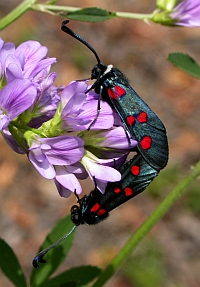 White-collared Burnets
White-collared Burnets
Zygaena lavandulae
© Teresa Farino
Butterflies and Moths of the Picos de
Europa - 2008 trip report
by Teresa Farino
3 - 10 July 2008
Seven very knowledgeable clients joined Teresa for another fascinating lepidopterological tour in the Picos de Europa, during which we recorded 101 species of butterfly in just seven days. We also positively identified more than 130 macromoths (both day-flying and in the moth trap), although a good many more were 'left by the wayside' as we simply didn't have the time or resources to track down many of the micros and the smaller geometrids. Here we deal with the families in taxonomic order.
Butterflies
The summer butterfly season in 2008 was extremely late. Following a superb early spring in April, the Picos de Europa (like much of western Europe) was subjected to a deluge of biblical proportions: near enough 40 days and 40 nights of continuous rain during May and the early part of June. As a result, we were able to observe species such as Green Hairstreak, Duke of Burgundy Fritillary and Marsh Fritillary that are normally long gone by early July, but the downside was a complete absence of some of the summer specialities, for instance, Apollo and Scarce Copper.
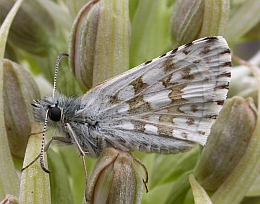 Safflower skipper
Safflower skipper
Pyrgus carthami
© Teresa Farino
We did rather well with the Hesperiidae (Skippers) this year, recording 15 species. The most exciting discovery was undoubtedly the Large Chequered Skippers that were bobbing around just behind the beach near San Vicente, where we'd made an impromptu stop on the way back to the airport. Six species of Pyrgus were positively identified, none of which was very abundant, with the rather distinctive Safflower Skipper in the Castilian plains taking pride of place, and we were also impressed by some stunningly fresh Marbled Skippers near Beges on the 9th of July.
Only two species of Papilionidae - Swallowtail and Spanish Swallowtail - made an appearance during this year's tour, although we saw both hill-topping together near Beges. Among the Pieridae (Whites; 11 species recorded), by far the most abundant species was the Clouded Yellow , but we also saw good numbers of Berger's Clouded Yellows and non-British butterflies such as Cleopatra and the now extinct Black-veined White. Our only sightings of Provence Orange Tip and Western Dappled White were in the same sheltered valley on the southern slopes of Coriscao on the 5th of July.
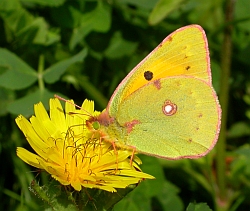 Clouded Yellow
Clouded Yellow
Colias crocea
© Teresa Farino
We observed 27 members of the Lycaenidae, most notably Dusky Large Blue exactly where predicted, plus a quite unexpected Large Blue near Tudes. The most abundant hairstreaks were probably Spanish Purple and False Ilex, but we also came across Sloe Hairstreak on the Castilian Plains, and a smart female Ilex Hairstreak near Beges, beautifully photographed by Andrew Burns. Although we were disappointed not to find any Scarce Coppers, Purple-edged Coppers were abundant in the higher, damper meadows, and it was an unexpected bonus to come across a newly-emerged Purple-shot Copper on the CD of Andrew's images for the week, although sadly none of us realized at the time.
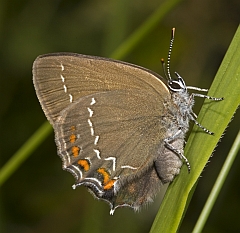 Ilex Hairstreak
Ilex Hairstreak
Satyrium ilicis
© Andrew Burns
After much diligent searching in rather cold conditions at the top of the Fuente Dé
cable-car, Richard Davidson finally located a solitary male Gavarnie Blue. Over the past few years, the paucity of winter snows in the Picos de Europa seems to have had a seriously adverse effect on the populations of this delightful little butterfly - here the endemic subspecies asturiensis - such that the overwintering caterpillars are subjected to prolonged temperatures below freezing, instead of being insulated by a blanket of snow. Other blues of note found during the course of the week were Lang's Short-tailed, Mazarine and Turquoise, plus a male Ripart's Anomalous Blue - again courtesy of Richard's sharp eyes - in the Castilian Plains.
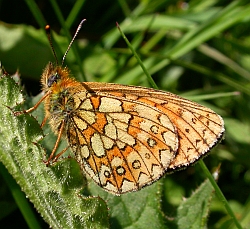 Bog Fritillary
Bog Fritillary
Boloria eunomia
© Teresa Farino
Among the 25 species of Nymphalidae we encountered were a couple of Purple Emperors down by the river near Teresa's house and several Cardinals on the plains, but by far the most notable event was the rediscovery of a small colony of Bog Fritillary - a butterfly immediately identifiable by the pale-centred postdiscal ocelli on the hindwing - that Teresa had located in 2004. We were also lucky enough to locate several False Heath Fritillaries - a scarce species in the southern Picos - on our last day, en route to the airport.
The Satyridae had not yet reached peak diversity in the Picos de Europa at the time of this tour, but even so we observed 20
species, with Teresa's 'secret' colony of
 Woodland Brown
Woodland Brown
Lopinga achine
© Teresa Farino
Woodland Browns definitely one of the highlights of the week, especially as the one we caught remained obligingly
docile for the photographers. We were disappointed by the absence of Lefèbvre's Ringlets at the top of the cable car - it seems this species is being affected
in a similar manner to the Gavarnie Blue by climatic change in the area - but we had good views of Chapman's Ringlet and Esper's Marbled White in the heights
of the Cordillera Cantábrica, as well as several encounters with enormous Great Banded Graylings in more Mediterranean habitats. Spanish Heaths and Spanish
Gatekeepers were located only in the Castilian plains on this occasion, although Iberian Marbled Whites are now securely ensconced in the south-eastern corner
of Liébana, and seem to be creeping progressively closer to the Picos proper as the winters grow milder.
Moths
 Goat Moth
Goat Moth
Cossus cossus
© Teresa Farino
Because we had very little rain during the week, we were able to set out the moth trap (an old-style Robinson trap powered by an 80W Mercury Vapour Lamp) on the terrace of Teresa's house every night. The tour started on the dark of the moon, so there was little celestial light to distract the moths, but overnight temperatures dropped to 9ºC on occasions, with a maximum of just 14ºC recorded. We also observed more than 25 species of diurnal moth during our daily forays into the surrounding countryside.
This year the Goat Moth was the only member of the rather primitive family Cossidae that came to the trap, but it was in perfect condition and posed splendidly for the photographers. Both the Drepanidae and Thyatiridae were also represented by just a single species: Oak Hook-tip and Figure of Eighty respectively.
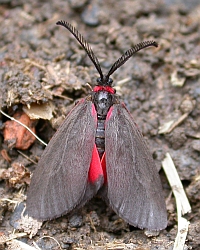 Aglaope infausta
© Teresa Farino
Aglaope infausta
© Teresa Farino
During the day we encountered seven species of the Zygaenidae, all of which were burnet moths except for the dinky little black-and-red Aglaope infausta, whose larvae can reach be a serious pest of rosaceous shrubs, particularly Blackthorn. Perhaps of the most distinctive of our Zygaena species was the White-collared Burnet of dry Mediterranean habitats (see photo at the top of the page), which is never found far from its larval host plant Dorycnium pentaphyllum; we encountered it both in the plains and near Tudes.
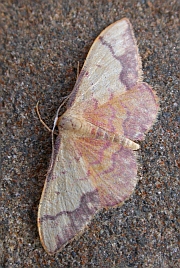 Idaea ostrinaria
© Teresa Farino
Idaea ostrinaria
© Teresa Farino
Although the publication date for the long-awaited Geometridae Ibericae has been put back yet again, this year we had a little help in the form of the excellent French book collated by Roland Robineau: Guide des papillons nocturnes de France, published in 2007 In addition, group member Ron Follows is a keen 'mother' in Britain and was able to confirm (or otherwise!) Teresa's geometrid identifications. In total, between trap and field, we managed to put a name to 35 members of the Geometridae, including two new species for Teresa's growing Picos list: July Highflyer and the day-flying Grass Rivulet.
 Broad-bordered Bee Hawkmoth
Broad-bordered Bee Hawkmoth
Hemaris fuciformis
© Teresa Farino
As usual, a number of non-British geometrid moths were recorded, including the handsome, if very small, Idaea ostrinaria, a species of Rhodostrophia (probably either vibicaria or calabria) that is awaiting identification and the distinctive pug Eupithecia breviculata. However, there is no doubt that the more flamboyant species such as Canary-shouldered Thorn, Blotched Emerald, Scalloped Oak and Swallow-tailed Moth attracted rather more of the photographers' attention!
Curiously, this year we didn't record any members of the Lasiocampidae, and - rather disappointingly - just five species of hawk-moths (Sphingidae) were observed. In the moth trap, we recorded Southern Pine, Poplar and Small Elephant Hawkmoths, while day-flying Hummingbird Hawkmoths were seen on numerous occasions, but were quite overshadowed by our discovery of a Broad-bordered Bee Hawkmoth near Tudes. This is only the second time that Teresa has seen this handsome, net-winged insect in the Picos de Europa, with the first record - in 2007 - being from exactly the same place.
-villica.jpg) Cream-spot Tiger
Cream-spot Tiger
Epicallia (Arctia) villica
© Teresa Farino
The Notodontidae were represented by eight species, all at light, with non-British species including Lesser Puss Moth (Cerura erminea) and Oak Marbled Brown, as well as the immigrant Three-humped Prominent, with the single member of the Thaumetopoeidae recorded being - as usual - the Pine Processionary. The Lymantriidae (3 species) were also rather poorly represented this year, with just Pale Tussock (all males), Black Arches and Yellow-tail coming to light.
Ten members of the Arctiidae (tiger moths) were recorded, including the day-flying Feathered Footman and Dew Moth, as well as a single male Clouded Buff, although these are more normally seen at light. Five footmen came to the moth trap, including nationally scarce British species such as Four-spotted and Hoary Footman. Of the tigers proper, only Ruby and Cream-spot put in an appearance.
More than 40 per cent of our moth observations from the week belonged to the Noctuidae (58 species). During the day we came across a number of day-flying
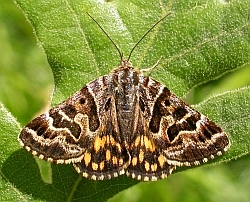 Mother Shipton
Mother Shipton
Callistege mi
© Teresa Farino
species, with Mother Shipton being recorded both in the Picos and on the plains, although Burnet Companions and Silver Ys were much more commonplace, while the only Beautiful Golden Y recorded was unexpectedly buzzing around the car park at Piedrasluengas.
Rare British noctuids seen during the week included Clay Fan-foot, Dewick's Plusia, Orache Moth, Heart Moth, White-point and L-album Wainscot, plus the immigrants Pale-shouldered Cloud and Pearly Underwing. We also encountered a very robust, mature caterpillar of the Sword-grass - another rare species in the UK - near San Glorio. Among the noctuids unfamiliar to British lepidopterologists were Mythimna scirpi, Noctua tirrenica and Violophotia molothina, all of which are regularly observed in the Picos de Europa, although we also encountered the rather distinctive Hadena magnolii, which was only the second record in twenty years for Teresa.
Important note: in Spain it is ILLEGAL to use a butterfly net or moth trap without a permit from
the relevant authorities, even if you do not take specimens.
Teresa Farino
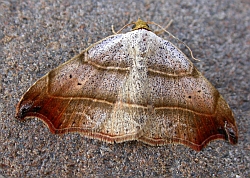 Beautiful Hook-tip
Beautiful Hook-tip
Laspeyria flexula
© Teresa Farino
Natural history tours in the Picos de Europa:
Butterflies and Moths of the Southern Valleys of the Picos de Europa
Natural History of the Picos de Europa and Páramos of Northern Castile
A Family Wildlife Holiday in the Picos de Europa
A Feast of Flowers - botanical trips to the Picos de Europa
Daily wildlife excursions in the Picos de Europa
Reports from past trips to the Picos de Europa:
Butterflies & moths of the Picos de Europa - 2008 trip report
Butterflies & moths of the Picos de Europa - 2006 trip report
Butterflies & moths of the Picos de Europa - 2005 trip report
A Feast of Flowers in the Picos de Europa - 2009 trip report
BSBI Botanical Tour of the Picos de Europa - 2004 trip report
Related information:
Picos de Europa - a naturalist's paradise
Complete list of butterflies for the Picos de Europa
Read about Teresa Farino
Wildlife holidays and natural history tours in Spain & Portugal
|